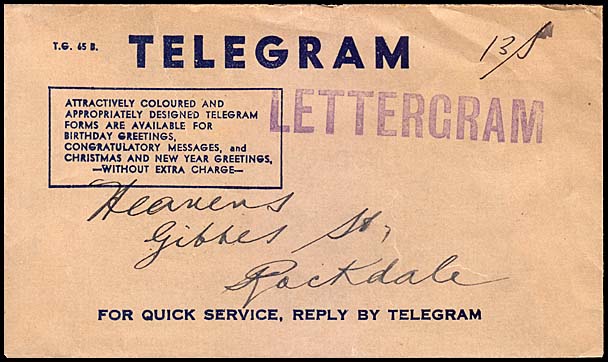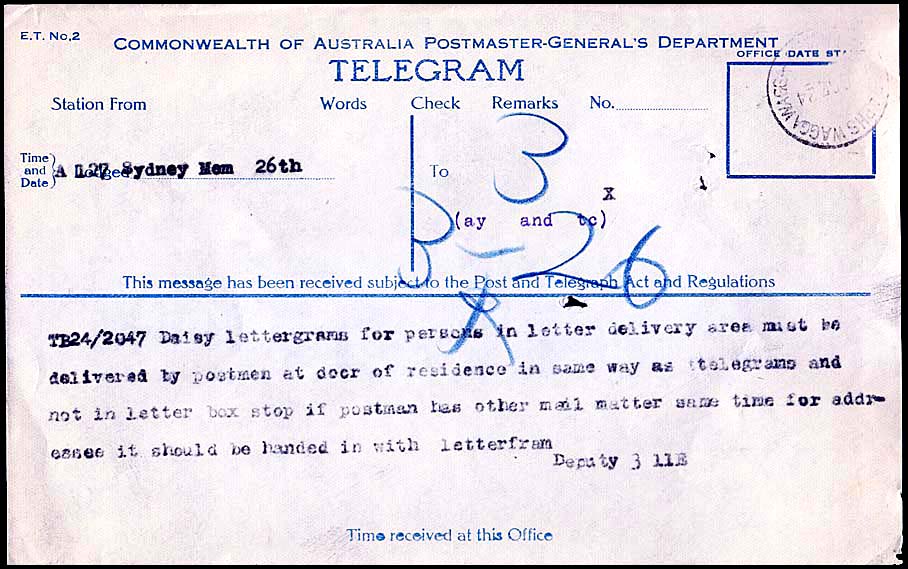Letter telegrams or Lettergrams.
- Australia 1901-1988
- New South Wales
- Queensland
- South Australia
- Tasmania
- Victoria
- Western Australia
- International
- Special aspects
The development of the Letter Telegram (or lettergram) service can be summarised as follows:
- first approach in New South Wales;
- developments in the 1912-14 period;
- markings to indicate a telegram was sent at the Lettergram rate;
- rates.
The introduction in New South Wales.
The concept of Letter Telegrams (quickly referred to as Lettergrams) was introduced in New South Wales on 1 March 1883. It provided for a message:
- to be sent at half the normal rate;
- to be marked "DELAYED";
- to be handed in during the normal hours of business but not be transmitted until after the office closed.
The system was so successful that it was stopped as from 1 July 1886. Too many people were using it rather than sending telegrams at the ordinary rate and consequently revenue was decreasing.
It does not appear that any other Australian Colony experimented with theLettergram facility.
In 1912, the English telegraph service under the Postmaster-General introduced a system of night lettergrams. This facility allowed telegrams to be sent during the night at a rate of six words for 1d. The telegram was delivered by the first post the next morning. Hence if a person missed the last collection of an evening but wanted their letter to be delivered early the next day, they were able to use this telegram option to send, for example, a 36 word message for sixpence.
On 3 September 1913, the Australian Postmaster-General Mr. Agar Wynne announced that a similar service but based on the Canadian model, was to be introduced in Australia. "By this arrangement, citizens of the Commonwealth would be able to send telegrams after office hours, and they will be delivered in the morning as letters by the postmen. There will be a general rate of one shilling for 40 words". The ordinary telegram rates at that time were 6d for 10 words (town and suburban) and 9d for 10 words (intra-state). The facility was restricted to messages of a personal or a social nature and was not therefore available for commercial or official messages.
A list of Telegraph Offices which could accept Lettergrams written on ordinary rate transmission forms was prepared and continually updated. Such offices were those which remained open after 6 pm. Announcements were made from time to time as to which Offices were being added or removed from the list. The Warwick Post & Telegraph Office was, for example, added to the list in May 1914 but later removed on the grounds that there was insufficient demand for the service in Warwick to justify the cost of keeping the Office open for an extended time beyond 6 pm. Letter telegrams then had to be submitted to the next available office.
This procedure was described for Warwick by the postmaster in the Warwick Daily of 2 November 1935: "as lettergram business was transacted at night after the ordinary telegraph messages had been put through, only those post offices which remained open at night could deal with this service. The nearest receiving office for lettergrams was Toowoomba and a person in Warwick desiring to dispatch a lettergram must ring the Toowoomba office and dictate his message there where it would be telegraphed and delivered at its destination in the following morning's post. In addition to the lettergram rate — 1/3 for 30 words and one half-penny for each additional word — the Warwick person would be charged the trunk line rate to Toowoomba - 5d for three minutes between 9. p.m and 7 a.m".
This story underlines the problem the Department had. The underlying reason for the introduction for the introduction of the Lettergam facility was not for a social good but instead to be a source of activity which could be completed by staff who had to work at particular offices to complete other tasks or to be on stand-by in case of emergencies. Such staff generally had considerable idle time. Lettergrams therefore provided them with something to do. The Lettergarm provision created a problem in the other direction - as in the NSW case in the 1880s, the system became too popular. The demand overwhelmed the"idle night hands" and actually required more people to behred for night shifts.
The Sydney Morning Herald was one newspaper from many around the Commonwealth to note the positive reception the facility had received:
"The lettergram system is proving popular. The Postmaster-General (Mr. Wynne) has been informed that these messages are being lodged in satisfactory numbers and in some instances the night staff at the telegraph offices find that there are as many of them as can be reasonably dealt with. In Sydney on one recent occasion, 1,200 lettergrams were lodged on one particular night. Of these, 400 were despatched by the night staff and the remainder had to be disposed of next morning".
In 1914 a trial was announced of allowing the public to lodge Lettergrams earlier than 6 or 7 pm. In November of that year however, the Postmaster-General became concerned that the facility was being abused and not being used just by individuals but by commercial concerns seeking to avoid payment of full costs.
"At present, if a man wants to avail himself of the opportunity of sending a lettergram, he has to wait about town to lodge his message at the telegraph office until after 6 o'clock. These messages, which are not sent till the business of the day has been disposed of, are delivered next morning by the letter-carriers on their rounds.
Ever since the scheme has been in operation, the public have clamoured for the privilege of being allowed to lodge their Lettergrams at any time of the day for disposal in the evening. The postal officials adversely reported on the suggestion, as they say it would interfere with the ordinary telegram revenue.
The Postmaster-General (Mr. Wynne), in the House of Representatives to-day, announced that, notwithstanding the official fears, he was disposed to give a trial for a month or two of extending the time for the lodging of the messages".
Clearly the trial was not succesful because, on 19 December 1918, an amendment to the Post and Telegraph regulations was issued to provide that Letter Telegrams were to be confined to messages of a social, domestic or private nature as distinct from matters of a commercial or official character. A major Conference of the Associated Chambers of Commerce of Australia, in March 1920, demanded the restoration for commercial use of lettergrams and for the restriction to matters of a social or domestic matter be lifted. The Conference saw that restriction as being "an obvious absurdity" although perhaps contributing to "economy".
By the end of 1923 (about the time the visionary Percy Brown became the permanent head of the PMG) the Postmaster-General announced that "it had been decided to include ordinary commercial messages in the lettergram service. ... at present only lettergrams bearing messages of a social nature were accepted after 7 o'clock in the evening for transmission by telegraph and delivery by the first post the following morning. Arrangements were now, being made to receive lettergrams, including commercial mesages, at any time of the day at all post offices which remained open after 7 p.m. The messages would be transmitted during the day and night, as opportunity offered, and would be delivered by the post the following morning". So the previous practice was re-instated.
As noted, the 1924 Regulations provided for the extension of the Lettergram facility to the commercial and official sectors.
There were no special forms used for Lettergrams. The most obvious indication was the matking made to a delivery envelope. The word LETTERGRAM was either handstamped or written on the envelope to signify delivery by the letter carrier/postman. The envelope to the right (AB-EO-7) has a Sydney date stamp on the reverese of 19 August 1936. |
 |
Telegram forms were supposed to have the words DELAYED or LETTERGRAM at the beginning of the message as shown for the telegram at the right. Few such inclusions are seen. |
 |
AB-DO-3A. An amazing survivor - a telegram sent from the Sydney Central Telegraph Office (probably as a multiple telegram) giving precise instructions about the delivery of lettergrams. Clearly the instruction was intended to clarify misunderstandings over paragraphs 2 and 5 in the new 1924 Regulations. The sender would presumably have been the Deputy Superintendent of the Telegram Branch in Sydney. |
Rates for sending Lettergrams.
The rates for Lettergrams gradually increased. These increases are summarised in the following table:
| Year | Charge | No of words allowed | Charge for each additional word |
| 1914 | 1/- | 40 | ½d |
| 1924 | 1/3 | 30 | ½d |
| 1949 (1 July) | 1/6 | 30 | ½d |
| 1952 | 2/- | 24 | 1d |
| 1967 | 16c | 20 | 1c |
PS: There is no connection known between the Lettergram used to send messages and the Lettergram who was a racehorse which trained over the mile at Caulfield about 1914.
In the Ormond Corinthian at Caufield on 14 November 1914, Lettergram was favourite at 2 to 1 before drifting out to 10 to 1 and then firming to 7 to 1 at the start. Lettergram was placed 4th in that race after making up a lot of ground in the last three furlongs.